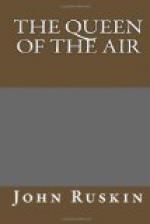In the Psalter of St. Louis itself, half of its letters are twisted snakes; there is scarcely a wreathed ornament, employed in Christian dress, or architecture, which cannot be traced back to the serpent’s coil; and there is rarely a piece of monkish decorated writing in the world that is not tainted with some ill-meant vileness of grotesque,— nay, the very leaves of the twisted ivy-pattern of the fourteenth century can be followed back to wreaths for the foreheads of bacchanalian gods. And truly, it seems to me, as I gather in my mind the evidences of insane religion, degraded art, merciless war, sullen toil, detestable pleasure, and vain or vile hope, in which the nations of the world have lived since first they could bear record of themselves—it seems to me, I say, as if the race itself were still half-serpent, not extricated yet from its clay; a lacertine breed of bitterness—the glory of it emaciate with cruel hunger, and blotted on the leaf a glittering slime, and in the sand a useless furrow.
72. There are no myths, therefore, by which the moral state and fineness of intelligence of different races can be so deeply tried or measured, as by those of the serpent and the bird; both of them having an especial relation to the kind of remorse for sin, or for the grief in fate, of which the national minds that spoke by them had been capable. The serpent and vulture are alike emblems of immortality and purification among races which desired to be immortal and pure; and as they recognize their own misery, the serpent becomes to them the scourge of the Furies, and the vulture finds its eternal prey in their breast. The bird long contests among the Egyptians with the still received serpent symbol of power. But the Draconian image of evil is established in the serpent Apap; while the bird’s wings, with the globe, become part of a better symbol of deity, and the entire




